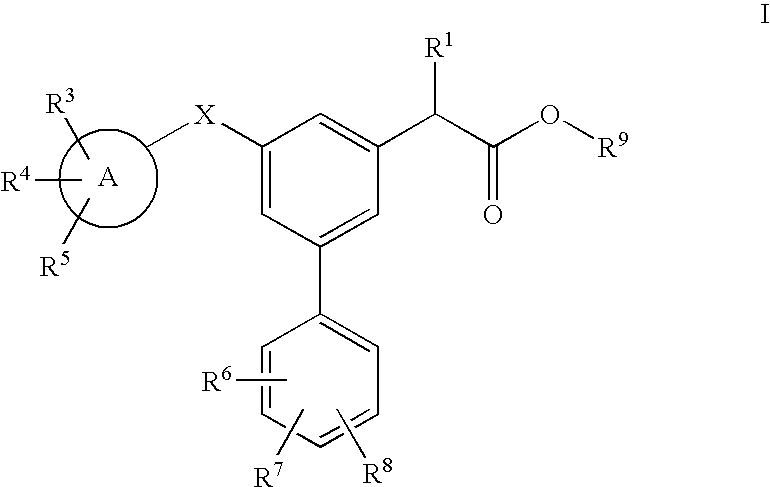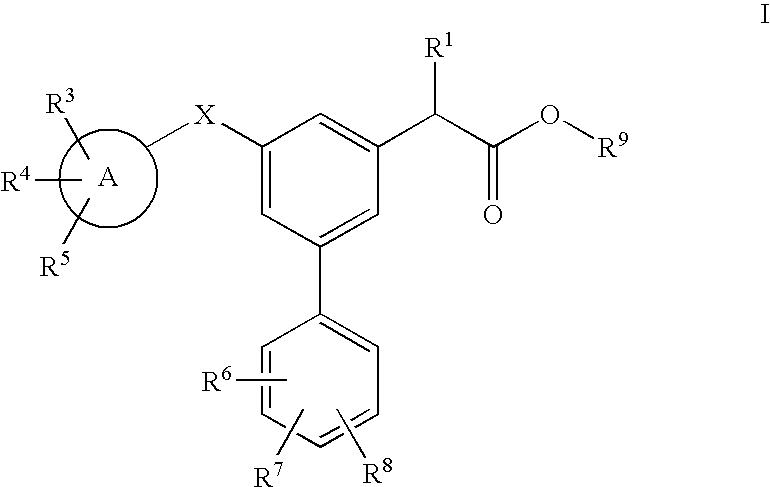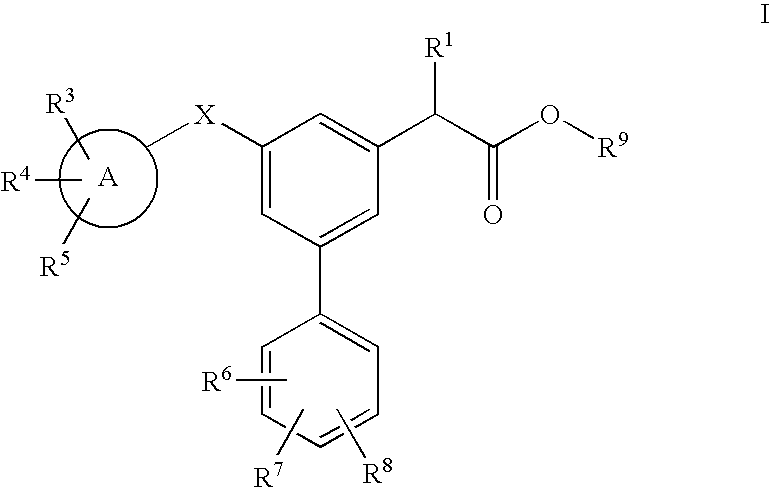Carbon linked modulators of gamma-secretase
a gamma-secretase and modulator technology, applied in the field of gamma-secretase carbon linked modulators, can solve the problems of low cns penetration, unwanted side effects, and no effective treatment of ad
- Summary
- Abstract
- Description
- Claims
- Application Information
AI Technical Summary
Benefits of technology
Problems solved by technology
Method used
Image
Examples
example 1
2-[5-(3,5-Dichloro-benzoyl)-4′-trifluoromethyl-biphenyl-3-yl]-4-methyl-pentanoic acid
[0196]
a) (3,5-Bis-benzyloxy-phenyl)-acetic acid methyl ester
[0197]
[0198]A mixture of (3,5-dihydroxy-phenyl)-acetic acid methyl ester (from Aldrich, 70 g, 0.385 mol), benzylbromide (137 mL, 1.16 mol), potassium carbonate (160 g, 1.16 mol) and DMF (1.5 L) under N2 was mechanically stirred at room temperature overnight. The resulting reaction mixture was poured into a mixture of 1.5 L of ice-water with stirring. The precipitate was obtained by filtration and washed with heptane successively to remove benzyl bromide to give the title compounds (123.7 g) as a brown solid which was air dried for the next reaction. 1H-NMR (CDCl3): δ 3.60 (s, 2H), 3.71 (s, 3H), 5.05 (s, 4H), 6.60 (s, 3H), 7.35-7.50 (m, 10H); Calcd for C23H22O4 (M+H) 363.15, Found 363.
b) 3-Benzyloxy-5-hydroxy-phenyl)-acetic acid ethyl ester
[0199]
[0200]A solution of 3,5-bis-benzyloxy-phenyl)-acetic acid methyl ester (50 g, 1.38 mol) and NaOH ...
example 2
2-[5-(3,5-Dichloro-benzyl)-4′-trifluoromethyl-biphenyl-3-yl]-4-methyl-pentanoic acid
[0215]
[0216]A mixture of compound 1g (50 mg, 0.098 mmol), 3,5-dichloro-benzyl zinc chloride (0.5M in THF, 0.588 mL, 0.294 mmol) and Pd(dppf)2Cl2 (7.2 mg, 0.0098 mmol) in THF (1.5 mL) was degassed with N2 for 6 min and heated at 120° C. under microwave irradiation (300 W, 250 psi) for 20 min. After cooling to room temperature, the solution was partitioned between EtOAc and NH4Cl saturated solution. The organic layer was dried (Na2SO4), concentrated and purified by column chromatography to give an ethyl ester intermediate.
[0217]The above ester intermediate was hydrolyzed following the same hydrolysis procedure of Example 1, step (2) to give the title compound; 1H NMR (400 MHz, MeOD) δ ppm 0.84 (dd, J=6.48, 3.30 Hz, 6 H), 1.39 (ddd, J=13.57, 6.72, 6.60 Hz, 1 H), 1.58-1.65 (m, 1 H), 1.83-1.91 (m, 1 H), 3.65 (t, J=7.83 Hz, 1 H), 3.97 (s, 2 H), 7.12 (d, J=1.71 Hz, 2 H), 7.16-7.19 (m, 2 H), 7.36 (s, 1 H), 7...
example 3
2-[5-(2,4-Difluoro-benzyl)-4′-trifluoromethyl-biphenyl-3-yl]-4-methyl-pentanoic acid
[0218]
[0219]The title compound was prepared from a Nigishi coupling of 4-methyl-2-(5-trifluoromethyl-biphenyl-3-yl)pentanoic acid (intermediate compound 1g) with 2,4-difluoro-benzyl-zinc chloride under the conditions described in Example 2; 1H NMR (400 MHz, MeOD) δ ppm 0.75-0.85 (m, 6 H), 1.37 (dt, J=13.39, 6.63 Hz, 1 H), 1.54 (ddd, J=13.69, 7.21, 6.97 Hz, 1 H), 1.85 (ddd, J=13.51, 7.52, 7.34 Hz, 1 H), 3.60 (t, J=7.83 Hz, 1 H), 3.92 (s, 2 H), 6.73-6.84 (m, 2 H), 7.12-7.19 (m, 2 H), 7.29 (s, 1 H), 7.37 (s, 1 H), 7.58-7.66 (m, 4 H); Calcd for C26H23F5O2 (M+Na) 485.16, Found 485.1.
PUM
| Property | Measurement | Unit |
|---|---|---|
| body weight | aaaaa | aaaaa |
| temperature | aaaaa | aaaaa |
| temperature | aaaaa | aaaaa |
Abstract
Description
Claims
Application Information
 Login to View More
Login to View More - R&D
- Intellectual Property
- Life Sciences
- Materials
- Tech Scout
- Unparalleled Data Quality
- Higher Quality Content
- 60% Fewer Hallucinations
Browse by: Latest US Patents, China's latest patents, Technical Efficacy Thesaurus, Application Domain, Technology Topic, Popular Technical Reports.
© 2025 PatSnap. All rights reserved.Legal|Privacy policy|Modern Slavery Act Transparency Statement|Sitemap|About US| Contact US: help@patsnap.com



